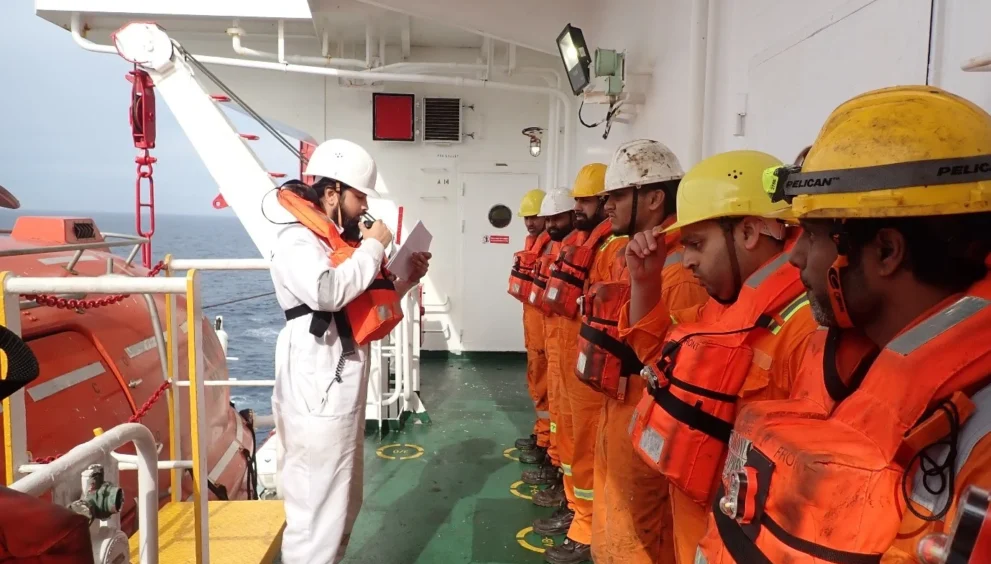At sea, swift response can save or destroy. Aboard ship, alarms are vital indicators—each alarm intended to bring to the attention of crew personnel particular kinds of emergencies or operational requirements. Whether you’re an experienced mariner or a cadet newly embarking, knowledge about these alarms can be the difference between life and death, between conformity and non-conformity, and between effectiveness and inefficiency aboard.
Let’s analyse the basic alarms all seafarers need to learn.
- General Alarm
This is one of the most critical alarms on board. It consists of seven short blasts followed by one prolonged blast on the ship’s whistle or alarm bells. It’s used to alert the entire crew and passengers of an emergency such as fire, collision, or abandoning ship. Once heard, everyone must proceed to their designated muster stations as per the muster list.
The general alarm is pretty much the ship equivalent of a full red alert — whatever you’re doing, you drop it and react.
- Fire Alarm
Fire aboard ships progress rapidly, so early warning is crucial.
How it sounds: Usually a steady ringing like the general alarm, but on some vessels, it’s an alternating set of tones or a recognizable bell sequence.
What it means: There is a suspected or reported fire on board. Fire personnel need to get dressed, and others go as trained in drills.
Today’s ships are equipped with fire detection systems, such as smoke and heat detectors that sound this alarm automatically.
- Abandon Ship Alarm
This is the most urgent alarm you’ll hear on board.
How it sounds: Seven short blows followed by one prolonged blow on the ship’s whistle and/or alarm system.
However, this signal alone does not authorize abandoning the vessel. It must be followed by the Master’s verbal order
What it means: All hands need to get ready to leave the ship. Life jackets on, assemble in the lifeboat stations.
This alarm only sounds when every attempt to master the situation has been unsuccessful and staying onboard is no longer safe.
- Man Overboard Alarm
Time is a factor in retrieving a person who’s gone overboard.
What it sounds like: A repeated Morse code “O” (three long blasts) on the ship’s whistle or general warning system.
What it means: An individual has slipped into the water. Lifesaving devices need to be launched, and a rescue operation is initiated.
Seconds here count. The crew needs to keep a visual on the individual, launch lifebuoys, and report to the bridge at once.
- Navigation Alarms
These are more technical but no less crucial for bridge officers.
Examples:
Shallow water alarm (depth sounder)
Radar proximity alarm
BNWAS alert (Bridge Navigational Watch Alarm System)
These alarms prevent navigational hazards, ensure proper watchkeeping, and help maintain a safe course.
- Machinery Space Alarms
Often sounded in the Engine Control Room (ECR), these alert the crew about critical engine or machinery issues.
Types include:
Low lube oil pressure
High exhaust temperature
Cooling water failure
Emergency stop triggers
These alarms don’t just keep machinery healthy—they prevent potential fire hazards and blackouts.
- CO₂ Release Alarm
Used when a fixed fire suppression system is on the verge of releasing carbon dioxide into a compartment—typically the engine room.
How it sounds: A clear siren or bell followed by countdown to gas discharge.
What it means: Clear the space immediately. CO₂ displaces oxygen, rendering it dangerous to remain inside.
It’s a back-up system and will only be deployed if fire cannot be contained using local or portable systems.
- Cargo-Related Alarms
Especially important on bulk carriers and tankers, they keep an eye out for conditions in cargo tanks and holds.
Examples are:
High temperature alarms
Overpressure alarms
Gas detection (particularly on chemical or LNG carriers)
On-board ships with hazardous cargoes, they will save lives by signalling leaks, poisonous gases, or hazardous conditions.
- Gas Detection Alarms
Gas detectors are common on oil, gas, and chemical tankers.
How it sounds: Usually a shrill repetitive sound or flashing light.
What it means: A hazardous level of flammable or poisonous gas has been found.
These alarms are very much related to personal safety—particularly in the case of enclosed spaces or tank cleaning.
- Low-Level Alarms
Not all alarms indicate danger, but all should be noticed.
Examples :
Low fresh water in tanks
Low fuel in settling tank
Sewage plant failure
Battery voltage drop
Not noticing these can result in severe operation problems later.
Final Thoughts: Alarms are only as effective as the Response
Alarms are useless if the crew isn’t trained to respond. Regular drills are performed on every vessel not only to check the SOLAS boxes, but to instill emergency reaction into the instincts of the crew. As a mariner, having the ability to recognize and respond to various alarm signals is just as critical as navigation or engine operation.
So the next time an alarm goes off, don’t freak out. Recognize what it is — and respond like a pro.


